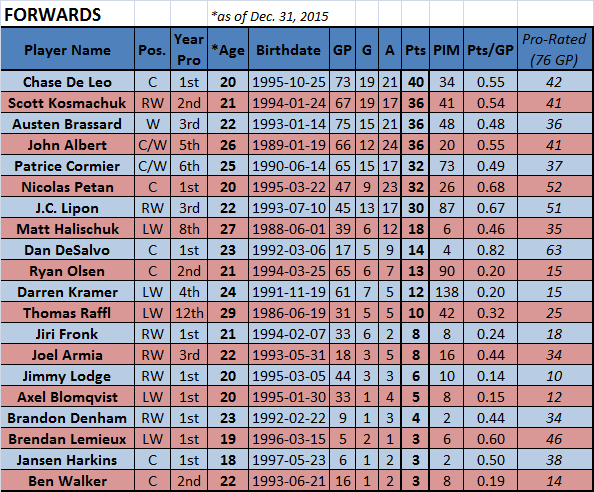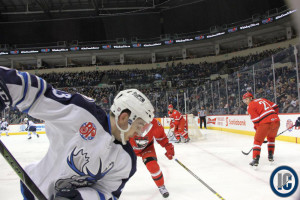Part 2 of our Manitoba Moose Year End Review assesses the play of the Moose forwards. Part 1 looked at the season in general and the contract of coach Keith McCambridge not being renewed. You can read that here.
Note: The review only includes those who finished the year with the club, or who may be back next season
The Scoring Leaderboard
Statistically, the Moose scoring leaders were not an impressive group this season. Not a single forward topped the 20-goal mark, and only one – Chase De Leo – hit 40 points:

However, that doesn’t mean that there isn’t some good talent here. For the average fan, the biggest question they have about a Moose player is “will they play in the NHL, and what kind of impact can they make?” That’s the intent of this article.
Prospect Grades
To assess a Moose player’s future NHL contribution, each significant Moose forward below is given a prospect grade, for example, “6A”. The number estimates the amount of potential, while the letter estimates the likelihood of achieving that potential. Here’s a rough glossary of what a grade means:
8 – first line NHL forward | 7 – middle-six NHL forward | 6 – depth NHL forward | <=5 – career minor leaguer
A – highly likely to achieve potential
B – somewhat likely to achieve potential
C – unlikely to achieve potential
D – remote chance of achieving potential
Moose Player Grades
Nic Petan – 8B
Among those who played at least half the season with the Moose, Petan led the team in points per game, registering 32 points in 47 games overall. After being sent down from the NHL on November 19, Petan made an immediate impact, with 13 points in his first 15 games, helping to jump-start an offence which was completely lifeless in the first quarter of the season. He brought the usual hallmarks of his game – the soft hands and tremendous vision which allows him to make plays which most others either fail to see, or don’t have the skills to attempt. Keith McCambridge was asked on a number of occasions about Petan’s penchant for backhanded, spin-o-rama passes, and McCambridge gave a consistent, but balanced answer, saying that the player needs to learn to pick his spots, but that you can’t take that play away from a player with his creativity.

Photo Credit: Rodney Braun
Generously listed at 5’9, Petan’s limitation is, and will always be, his size. However, his skating is exceptional, and his ability to think on the ice is at near-elite levels, so it’s unlikely (in my opinion), that size will hold him back. In terms of an NHL style comparison, he’s similar to Minnesota’s Mikael Granlund, a small Finnish centre who displays similar vision and creativity despite his 5’9 frame. Whether Petan has the upside to reach first-line status is unknown, but given his impressive arsenal of skills, and the level of progress he showed in adapting his “small man’s” game to pro hockey – both in the AHL and the NHL – tells me that he has what it takes to be a big contributor in the middle of an NHL lineup one day. As with most young players, pinning down an exact arrival date is nearly impossible, and also unwise.
Joel Armia – 7B
While Armia’s Moose totals don’t wow you – 3 goals and 8 points in 18 games – the numbers are deceptive : you have to consider that in the first 21 games of the season, the Moose scored just 35 goals – not even two per game. Most of Armia’s games fell into that 21-game stretch, so I’d give him a pass in terms of point production. As for his play, he was quiet in the first few games of the year, but in the next 15-18 games, he was the best Moose skater on the ice on most nights. He showed a consistent ability to create scoring chances, using his 6’3 frame, silky hands, good vision, and a terrific wrist shot. He’s about equally good at creating plays for others, and finishing them himself, and for a guy who came with a bit of a reputation as soft” or “lazy”, his stint with the Moose helped dispel that notion, and his play with the Jets further helped that cause.
While he seems to possess the complete package of skills, the upside for Armia has always been somewhat of an unknown. While he is a 1st round pick, who posted nice totals during his time in the top Finnish league, he has yet to impress statistically in North America, which makes one question if he really has the kind of skill to post significant numbers in the NHL. That said, he didn’t look out of place in the NHL this season, particularly in February when he was elevated in the lineup. Based on what we’ve seen so far, it seems reasonable to think that Armia can play in the top-9 of an NHL lineup. If Armia were to add a little more speed – especially in his first two or three steps – and get a little confidence, he will be a very useful NHL player indeed.
Scott Kosmachuk – 7C
It was a tale of two seasons for Scott Kosmachuk – he was disturbingly quiet offensively early in the season, but was the best Moose forward in the last third of the season. Early on, it seemed that he was suffering from a lack of confidence – his very first goal of the season came in the 9th game, on a shot essentially from the corner, and it seemed to really boost his play. But after a few more productive games thereafter, he went into another lull, and you started to wonder if he was really a prospect worth following. But then in mid/late December, he was united with Nic Petan, and things started to click. Here are his season splits:
First 36 GP – 5G, 9A, 14P
Last 31 GP – 14G, 8A, 22P
Kosmachuk is known as a shooter, and for good reason – he has a heck of a wrist shot, certainly the best on the team. But what surprised me was how good his playmaking ability was. One of the Moose highlights of the year was an incredible saucer pass he laid on the stick of Austen Brassard for a nice goal; the beauty of the play was that Brassard had a back-checker, so Kosmachuk had to feather it in just perfectly without it being picked off, or missing Brassard entirely. As for weaknesses, Kosmachuk is average in size – a hair under 6 feet – and while his speed is decent, he isn’t the smoothest of skaters. At times, he has a bad habit of reaching, rather than moving his feet. However, the most heartening thing about his season was the apparent improvement in his skating. When he went up to the Jets, he looked like a totally different player, as if he was 25% faster than ever before, and when he was sent back down to the Moose, he maintained that speed, and was blowing by defenders in ways he never did earlier in the season. The challenge for him is to continue to improve his speed, and establish a level of consistency that has eluded him so far in his career. He definitely has the potential to play on an offensive line in the NHL, but he doesn’t have a well-rounded game to fall back on in the event that he can’t create consistent offence in the toughest league in the world.
Chase De Leo – 7C
Chase De Leo was one of the biggest surprises for the Moose this season. A 4th round pick, 99th overall in 2014, standing 5’8, De Leo is the type of player who usually takes a while to transition from the CHL to the AHL. And yet, he was probably the most consistent forward for the Moose all season. With 40 points in 73 games, he led all Moose forwards in scoring (1 point behind d-man, Brenden Kichton), and placed 18th in rookie scoring, league-wide. He was also the first Moose player to record a hat trick this season, and had by far his best game of the year in the club’s home finale, with 2 goals and 1 assist, including an incredible shot to tie the game late in the third.
De Leo’s biggest strengths are his shot – he loves picking corners, and beating goalies high – his puck handling, and his tenacity and desire. He’s the type of player who never gives up on a play, who wants to have the puck, and who desperately wants that puck towards the net, whether that means a nifty pass, lugging it through traffic himself, or a shot from a seemingly tough angle – which he can often make good on. His off-ice demeanor is also impressive – he keeps an even-keel, with a quiet swagger that comes across as strong inner belief, rather than cockiness. However, at 5’8, his size is a big issue, and unlike Nic Petan, De Leo’s skating isn’t where it needs to be to create space for himself at the NHL level. If he were able to become an elite skater, then he has a good chance of playing an offensive role in the NHL; currently, he has just enough speed and acceleration to pull away from AHL defenders – not nearly enough to do so in the NHL.
J.C Lipon – 6B
In his third year in the AHL, Lipon had a strong season. He was very good in the middle portion of the season, despite two different, significant injuries, and earned a call-up to the Jets late in the year. He finished second to Nic Petan in points-per-game among those Moose who played a large chunk of the year, and was productive in all situations – even-strength, powerplay, and while shorthanded. However, Lipon’s year needs to be looked at with a bit more scrutiny than some of his predecessors on this list, since he has more AHL experience. While the following statement is incredibly general, it also tends to be quite true: the earlier you post good stats at a level of hockey, the more upside you tend to have. In this case, you can’t compare Lipon’s 30 points in 45 games (3rd year pro) to Nic Petan’s 32 in 47 (1st year pro), since Petan is essentially starting from scratch. If you look at similar situations around the AHL, no one would suggest that Kevin Fiala – the 11th overall pick in 2014 – has similar upside to teammate Max Gortz, even though their stats are fairly similar. (Fiala is a high-end prospect, while Gortz is a player who started the year in the ECHL).

Photo Credit: KJ Rocan
Lipon is a feisty competitor, who is tenacious with and without the puck. He likes throwing the body, blocking shots, and doing all the little things that coaches, teammates, and most fans, really respect. He also improved his skating a lot in the last 12-18 months – in his second NHL training camp, one of the main things I noticed about him was how slow he looked, but this past year, his speed was a definite asset, at least at the AHL level. He also has a hard shot, though perhaps he is a bit liberal with it at times, given that it could be a lot more accurate. The issues with Lipon’s game involve vision and hockey sense – he often makes bad choices with the puck because he doesn’t see other, better options which may be available to him. (In this way, he’s like the anti-Petan.) Also, he doesn’t have the softest hands for playmaking when he does spot a teammate open. Another concern is that his frame – 6′, 185ish – may not hold up if he is hell-bent on playing the physical style he’s shown so far in his career, particularly at the NHL level against bigger, stronger players. Lipon is an NHL prospect, but one whose upside is as a 4th line guy.
Austen Brassard – 7D
I once asked Keith McCambridge if Austen Brassard was underrated – his immediate reply was “well he’s not underrated to us”. Brassard is a skilled player who had trouble establishing himself offensively in his first two AHL seasons, but was able to break through this year, with 15 goals and 36 points. He was very productive in the middle of the season – he had a stretch of 7 points in 8 games in December, and another run of 10 points in 12 games in February – and was one of the offensive leaders who helped the club pick up its socks. At 6’3, 207, Brassard is a big man with a long reach, and a hard, accurate shot, which he used on a number of occasions to beat goalies from a fair distance, (right around the left face-off dot on his off-wing). He also has surprisingly soft hands in tight, and is known to deke a goalie on occasion. For Brassard, the issues are consistency, intensity, and skating. He doesn’t have the motor of a player like Lipon or De Leo, who are always buzzing – he often disappears for a few periods, or even a few games at a time. Once he gets up to speed, his skating is fine, but his first three or four strides are nowhere near NHL-level. If he can improve his skating, he might get a look at the NHL, but his lack of intensity – whether real or perceived – is harder to fix.
Dan DeSalvo – 7D
A player like Dan DeSalvo is usually labeled immediately as a “tweener” – one who is (or will be) a fantastically productive minor-league player, but who doesn’t have the potential to contribute at the NHL level. After finish college at the end of last season, DeSalvo started the year in the East Coast league, and was named to the ECHL’s all-rookie team, after leading Tulsa in scoring with 51 points in 55 games. Following that successful stint, he came to the Moose and added another 14 points in 17 games, ending the year with an 8-game point streak. In some ways, DeSalvo is similar to Nic Petan – small, with silky hands and great vision. However, DeSalvo is even smaller – 5’7 tops – not as quick as Chase De Leo (who needs to get faster himself), and older than each of them by 3 years. If the Moose choose to sign him next year, he could be a big contributor to their AHL success, and a fun player to watch. Who knows, there’s even a tiny chance that he becomes this club’s David Desharnais.
John Albert (5A), Patrice Cormier (5A), & Matt Halischuk (5A)
Albert, Cormier, and Halischuk are all hard-working veterans who were looked upon as a good veteran core for the Moose to start the year. Of the three, Albert had by far the most impact – though he struggled early in the year with injuries, and later, with the weight of the captaincy on a struggling club (his words in his exit interview), he came on late in the season and was one of the Moose’s best players. Patrice Cormier played a handful of very good games, but overall, had a disappointing season. He was looked upon to provide a leadership role on the club, and while that may have happened in the dressing room, he was rarely one of the top players on this team for any significant stretch of time. Meanwhile, Matt Halischuk was invisible for much of the year, and was not missed when he was called up to the NHL. Overall, none of these players can be considered prospects anymore, as they have all played 5+ years of professional hockey, and have shown their “ceiling”. Each of them provides some organizational depth – particularly Albert – but their NHL upside is very limited at this point.
Jimmy Lodge (6C), Ryan Olsen (6C), Axel Blomqvist (6D)
Jimmy Lodge and Axel Blomqvist both started their first year pro this fall, while Ryan Olsen returned for his second year in the AHL. Offensively, there isn’t much upside in this group. Lodge took 43 games to score his first goal – ironically, recording a hat trick in the second last game of the year. He did make strides as the year went on though, struggling early, looking comfortable later in the year, and exploding offensively in that one game. He needs to gain a lot of strength and speed, and given that he just turned 21, he has time to do it. Ryan Olsen is a big centre who plays a tough game – he’s hard on the forecheck, and will stand up for teammates when he feels it’s needed. He’s a good skater for his size, and has decent puck control. However, his skills are quite limited in terms of finish, passing, vision, etc., and his hockey sense and general decision making are a problem. He may play a few games in the NHL, but it’s hard to see him ever taking a regular shift given his deficiencies. For most of the year, Axel Blomqvist struggled to adapt to the pace of play. At 6’7, he doesn’t yet have the leg strength to be solid on his feet, or to have much acceleration. While Lodge and Olsen at least showed glimpses of skill, Blomqvist was pretty silent on that front all year. All that said, players like him tend to need time to grow into their bodies, and occasionally one of them becomes a power forward out of nowhere; however, most players with his track record – undrafted, limited stats at any level – tend not to flip the switch suddenly.
Jiri Fronk (7D)
Jiri Fronk showed flashes of high-end skill this year for the Manitoba Moose. He also went long periods of time as a healthy scratch, and there seemed to be some disagreement – even tension – between himself and the head coach. Fronk is a sniper, who combines good size and speed with very slick hands and a hard wrist shot. He scored a few “goal scorer’s goals” this season, and was one of the more popular players on the team from a fan’s perspective. He managed to score 6 goals in the first 20 games (or so), despite playing very limited minutes on the 4th line – this at a time when few other players had more than 6 goals. However, he went silent the rest of the season, and barely got in the lineup down the stretch. While he has more upside than Lodge, Olsen, and Blomqvist, those three have an entry-level contract with the Jets, and he does not. Based on the way the season ended, it’s likely that he won’t be back with the Moose next year.
Brenden Lemieux & Jansen Harkins
Given that they only played a handful of games with the Moose, it would be unfair to rate them at this point, but suffice to say that both players were impressive in their professional debuts. Brenden Lemieux was a little quiet in his debut, but then posted 2 goals and 1 assist in his last 4 games, playing a top-6 role and being one of the best skaters on the ice. He has a fairly unique combination of physical abilities – size/speed/strength – along with a goal scorer’s shot, and good overall skill. He’s also keenly aware of what parts of his game need to improve in order to get to the next level – chief among them, becoming a reliable two-way player that can be thrown out in any situation. Based on a brief glimpse of him, he looks like a top-9 NHL’er who isn’t too far away from taking a regular shift. While Lemieux was coming off an impressive final junior season, Jansen Harkins was coming off a disappointing year statistically, where his points total dropped significantly from the year prior. However, he put together a very nice stint with the Moose, looking very comfortable as an 18-year-old playing against men who are primarily in their mid-20’s. Harkins is a playmaker with very good hockey sense and a strong work ethic. While he doesn’t have high-end skill, he seems to be in good position most of the time, and between that and his excellent passing skills, he seems to make his linemates better. The good news on him is that his weaknesses – strength and speed – are things he can work on over time. Once he strengthens his legs, and develops an extra gear in speed, he looks like a player who has more than enough skill and smarts to contribute somewhere in an NHL lineup.
———————————————————
Part 3 will be a review of the Moose defencemen.



